
About 20 km southwest of Soria we find the site archaeological site of the Roman villa La Dehesa . On the one hand one of the most spectacular in Spain, although on the other, a mystery still unsolved, since not enough evidence has been found to confirm what its true use was.
Despite the fact that the “pagan monastery” binomial may come as a surprise, mixing an eminently Christian building with paganism, which is ultimately a religion prior to the arrival of monotheisms, through these lines we will try to shed some light on these doubts.
Its discovery and value.
When in 1928, a resident of the town of Cuevas de Soria found some strange "colored stones" in a field near the town, he could not imagine that under them he would find a spectacular Roman villa of more than 4,000 m2. The discovery of those tesserae quickly reached the director of the Numantino Museum, Blas Taracena, who, together with his friend José Tudela, began the excavations a few months later. After two years of the same, the first Roman villa that was in the Iberian Peninsula came to light. That impressive archaeological site was declared a Historic-Artistic Monument in 1931.
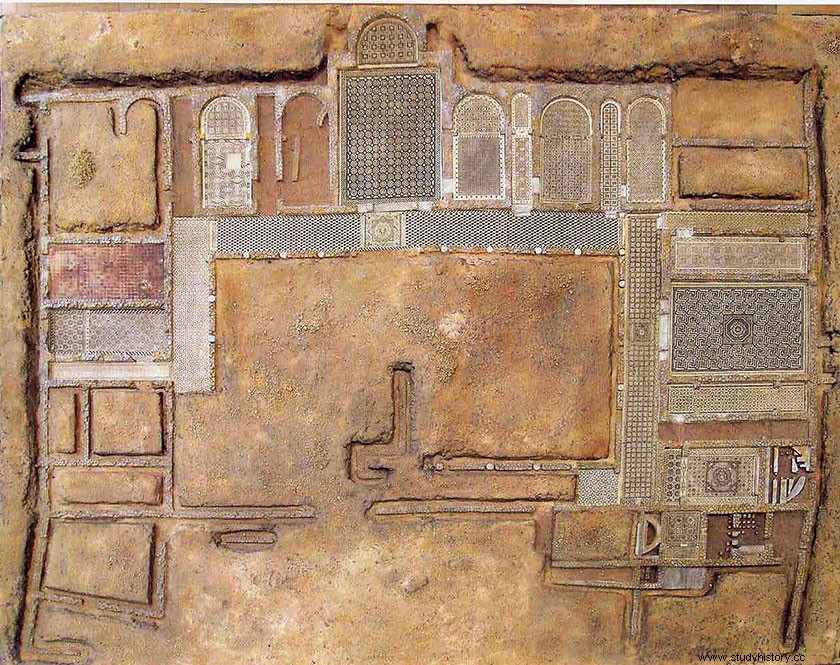
Plan of the Villa La Dehesa site.
From that moment on, the Civil War and the post-war period would lead our protagonist to oblivion, until 1980 when the excavations resumed. Unfortunately, as usually happens in these cases, the mosaics began to "emigrate", today the two most spectacular are in the MAN in Madrid.
Since then, the work has continued both from the archaeological point of view and from the point of view of consolidation with the diversion of a small stream that periodically flooded the area. Finally, after covering the entire site, in 2012 it was opened to the public.
The visit to the Roman Villa La Dehesa.
The first thing that should be said, to those who go to the town of Cuevas de Soria to discover this late-Roman town, is not to be scared when they see the grotesque industrial warehouse that They will meet when they arrive. Below it, as we have already said, is one of the most spectacular Roman villas in the entire Peninsula.
The visit to this museum complex is divided into two parts. The first of these is the museum called "Magna Mater", which is actually the name of the musealization project undertaken by the Diputación de Soria and the Junta de Castilla León, to value the three Roman villas in the province of Soria. Apart from our protagonist, the works in the villas of "Los Quintanares" and "Los Villares" are followed, to put them in value. Of all the museum, the most remarkable is the exhibition that shows how mother nature has influenced different cultures, from prehistory to the present. This brings us closer to the true meaning that those responsible for the site have given to it. It is evident that they do not have the necessary samples to be sure, but this nod to Mother Nature, together with the name of the museum, are significant samples of their opinion regarding the past of this Roman villa.
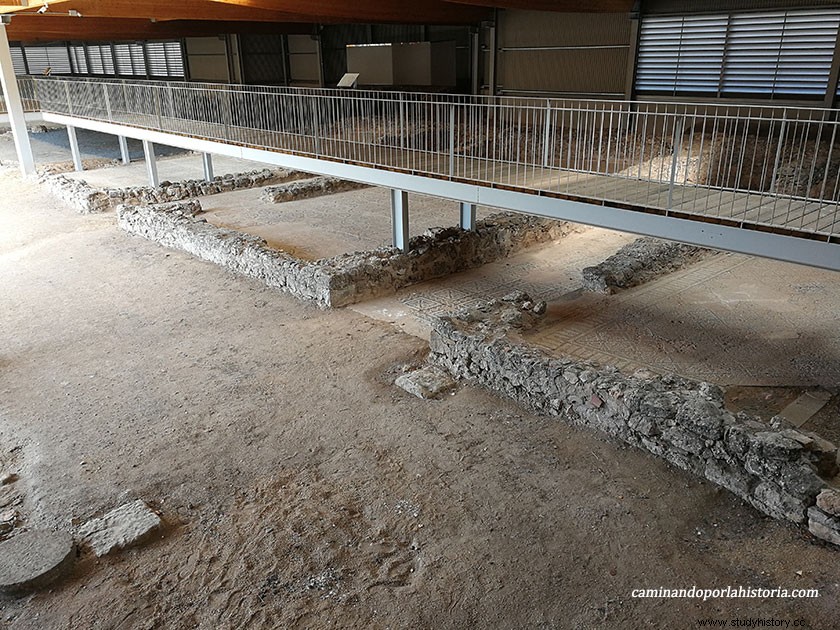
The site and the walkway from where you can visit.
After the museum, the visit runs on a walkway equipped for the knowledge of the site itself. In this section I think it is important to point out that the visit is guided, it is in itself, it is a tour through said walkway to observe the mosaics and the different rooms that the town had, but the explanations of those responsible lead us to reflect on the old utility that had the same, by the way the explanatory video at the end can also help.
To find out timetables and prices, it is best to check the following website:villaromanaladehesa
Pagan monasteries.
To explain a little better what is seen at the site, different preliminary reflections must be made, since the main thing is the condition of mystery that it has. From this point we will mix the visit to the site, with a new book written by Dimas Fernández-Galiano, which is titled; Pagan monasteries, flight from the city in the ancient world .
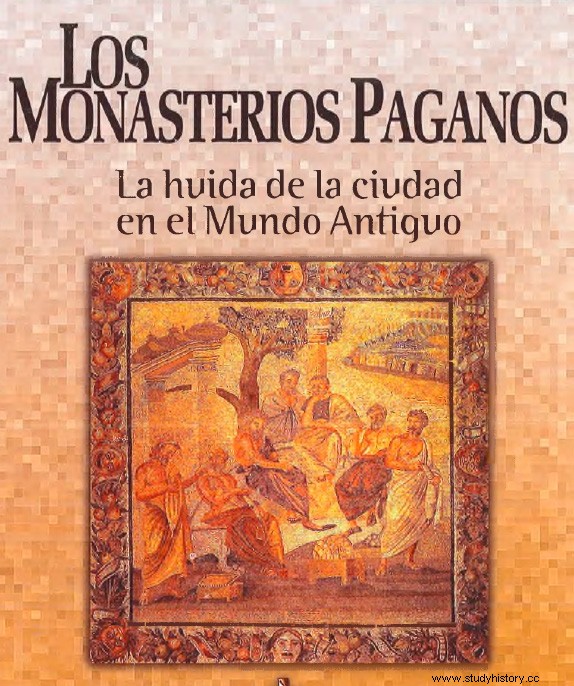
Cover of the book by Dimas Fernández-Galiano
Only with the mere observation of the structure that Villa La Dehesa had, we can already draw two quick and obvious conclusions. The central courtyard “atrium ”, on which the different rooms are distributed, both in this town and in the rest of Roman culture, is still the later cloister of any Christian monastery. On the other hand, the experts assure that the building had a double floor, with the exception of the central parts in which the rooms were higher. This aspect can remind us of the ancient Islamic madrasahs, where the students resided in the upper rooms, while the lower ones were occupied by the classrooms.
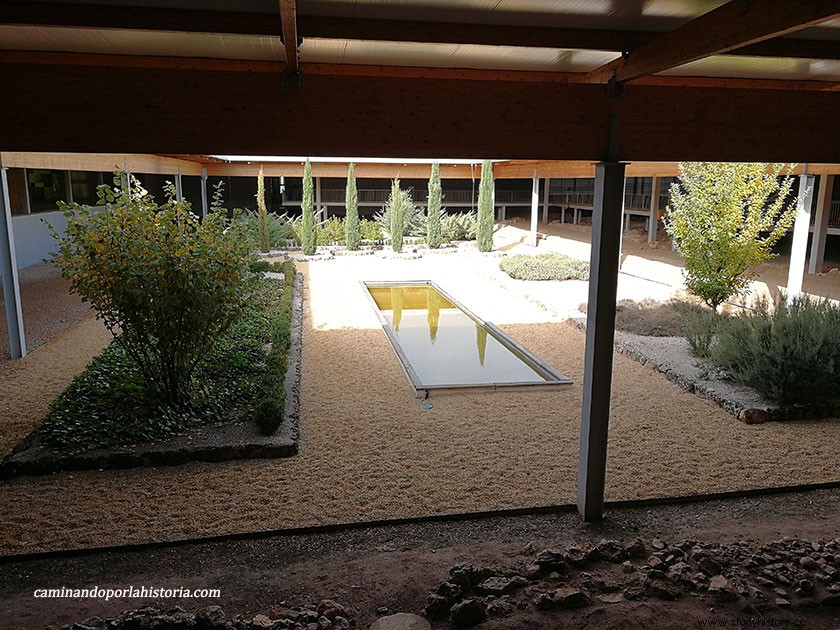
Musealization of the atrium of Villa La Dehesa
After these two personal assessments, we can return to the book in question. In it, its author takes us on a journey through the world of monastic life. One of the first things that can draw our attention is the beginning of the monastic life for the author. If traditionally it has been thought that the refugee Christian anchorites in the Egyptian region of Tebaida are the seed of the medieval monasteries, Dimas makes us see that even the Pythagoreans of the V century a. C. they already exercised this practice in one way or another, obviously not from the Christian tradition.
But it will be in chapter VII, when the author leaves us the necessary clues to see in the Villa La Dehesa a pagan monastery. In the first place he reminds us how in the time of the Antonine emperors (2nd century AD) a certain freedom of worship began in the Empire, which would culminate in the 4th century with the serious known religious clashes, especially with Christianity. At the same time that interest in going to temples of worship is lost, taking religious practice to private homes. In addition to mentioning the appearance, for the first time in Roman culture, of a kind of religious leaders.
To continue the story, the author takes us to Roman Hispania, where from the end of the 3rd century Roman villas began to be built with increasing impetus. The main cause has been blamed on the great economic crisis suffered by the Roman Empire in that century, but this alone cannot and should not justify the construction of villas, such as the Dehesa in Soria.
The Roman villa La Dehesa.
Our protagonist begins to build in the middle of the fourth century BC. Apparently on an old building, which could have been completely removed to place on top of it the new villa of about 4,000 m2. Here the questions begin, since it is possible to come to think, as on the other hand it must have been the usual thing at the time, that the town of La Dehesa had an agricultural economic background, or rather livestock, the main activity of this region in Roman times. . But to date no remains of this activity have appeared, except for some small room, which at most could have been used for personal consumption.
Therefore, and as those responsible for the Roman Villa La Dehesa do , we need to find a meaning for this construction. Although Dimas Fernández-Galiano generalizes in his book, without a doubt chapter VII to which I refer in this article, seems to have been written with the town of Soriana in mind. As the author says; archaeology by itself it cannot give us all the solutions, and archaeologists in relation to the Roman villas that proliferate from the Lower Empire, it seems that it is difficult for them to find another meaning for them that is not agricultural or livestock. But the Roman society of that time was more complex than we might think, religion was a continuous battlefield and according to Dimas, some Roman villas must have acted as both a social and spiritual escape from the turbulent cities. This is the meaning that the author seems to give to the Roman Villa La Dehesa.
The rooms of the Roman Villa La Dehesa.
Despite the above, if we combine archaeology, through a visit to the site, with the book of Pagan Monasteries, we can end up fitting some pieces of the mystery about the Villa of the Dehesa.
Those who came to the town in the fourth century, the first thing they found were the baths, although their size was not very large compared to the rest of the building. Its main function was the cleaning and purification of those who arrived, but a discovery caught our attention, a bathtub where supposedly baptism or initiation rites had been carried out.
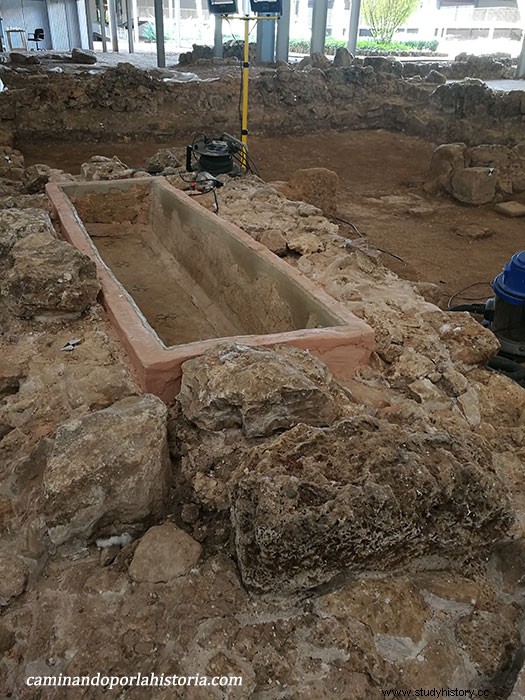
The bathtub at Villa La Dehesa
Next to it, the private parts of the house were found, this fact is deduced from the fact that it was the only area of the town that had heating through the ducts of adjoining hot springs. Next and following the corridors adjoining the peristyle was a possible dependency as a family mausoleum. By the way, a peristyle that served the same purpose, as I have already mentioned, as the medieval cloisters, evidently the distribution of the main rooms of the town. As in other cases, the one in the town of Soriana had various fountains, ponds and plants that simulated paradise.
But there are two architectural elements that have most made us think of the monastic utility of the Roman villa La Dehesa , by the way neither of the two are usually very common in these constructions. The first of them the corridors between the rooms of the north sector of the house, which was the opposite of the entrance. Its usefulness could be twofold, on the one hand to prevent the direct entry of cold into the supposed classrooms, and on the other hand, that it was the waiting place between one activity and another, by the students. The second of these constructions, the largest room in the entire town and finished in an apse like the previous classrooms. Its use could have been that of the main hall, or room where the cult was carried out, by the owner of the town and it could have been presided over by the main figure of the town, who we will know after a few lines.
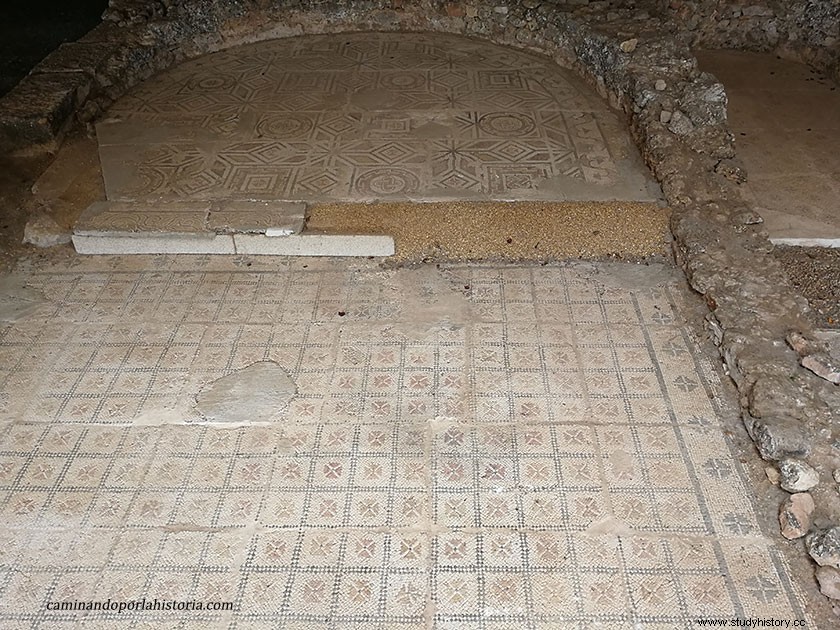
Aula Magna, you can see the step where a supposed leader of the cult used to climb.
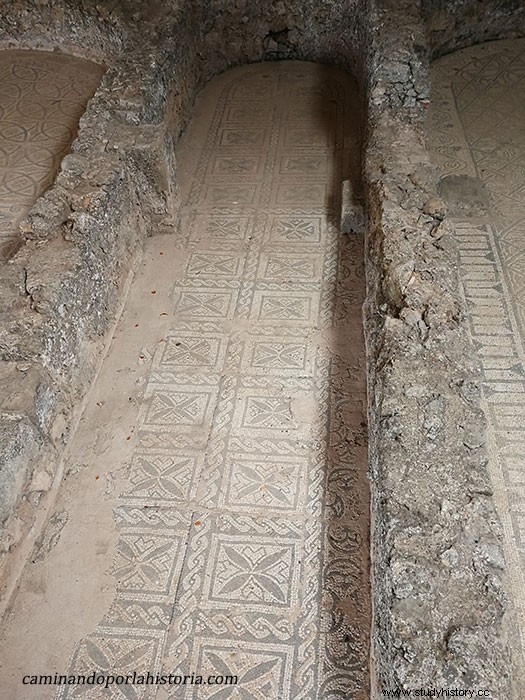
Corridor that separated the rooms.
Conclusions.
After the above, we only have to meet the family that was able to bring this religious space to completion. The findings of a large part of the mosaics of the same symbol led to the conclusion that the Dehesa villa was owned by the Irrico family. It was known as one of the families that had best maintained the pagan religious past of Celtiberian tradition. Entering again into the field of assumptions, who can deny us, that the Villa Romana La Dehesa, was not a place of worship to Mother Nature ? To continue with the imagination, a great meeting place where ancient pagan traditions are kept alive, to which people possibly came from different corners to learn and transmit it. But it is evident that his journey should not have been very long, since the arrival of the barbarian peoples led him to ostracism.
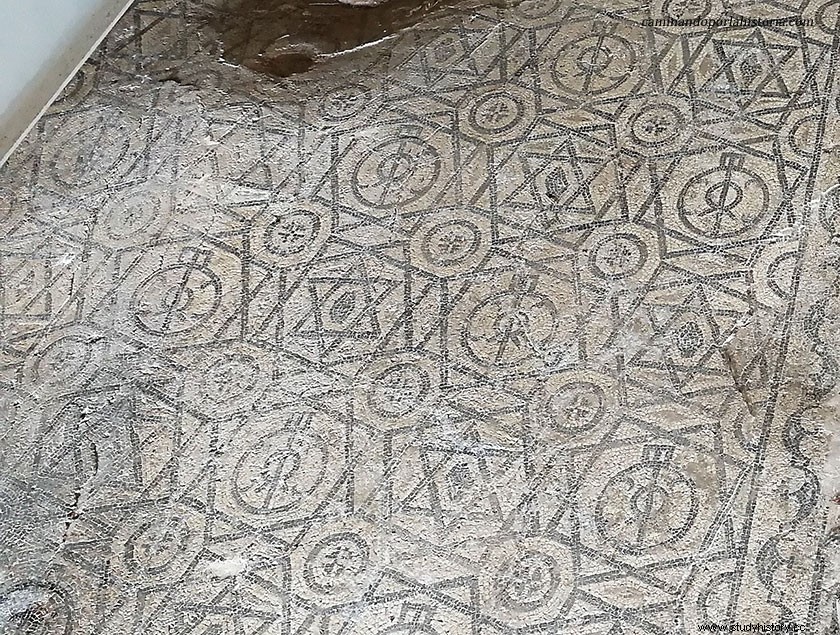
Mosaic with the symbol of the Irrico family, next to a six-pointed star.
I cannot conclude without saying that everything exposed here falls into the field of hypotheses. But not only mine in this article, but those responsible for the site who make clear what they think, despite not saying it openly, by putting "Magna Mater ” This space has become a museum.
More info:The pagan monasteries, the flight from the city in the ancient world, Dimas Fernández-Galiano, Ed. El almendro de Córdoba, 2011.
